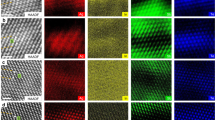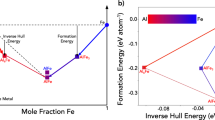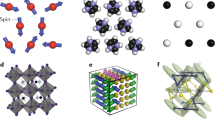Abstract
Phase-change materials are characterized by a unique property portfolio well suited for data storage applications. Here, a first treasure map for phase-change materials is presented on the basis of a fundamental understanding of the bonding characteristics. This map is spanned by two coordinates that can be calculated just from the composition, and represent the degree of ionicity and the tendency towards hybridization (‘covalency’) of the bonding. A small magnitude of both quantities is an inherent characteristic of phase-change materials. This coordinate scheme enables a prediction of trends for the physical properties on changing stoichiometry.
This is a preview of subscription content, access via your institution
Access options
Subscribe to this journal
Receive 12 print issues and online access
$259.00 per year
only $21.58 per issue
Buy this article
- Purchase on Springer Link
- Instant access to full article PDF
Prices may be subject to local taxes which are calculated during checkout




Similar content being viewed by others
References
Wuttig, M. & Yamada, N. Phase-change materials for rewriteable data storage. Nature Mater. 6, 824–832 (2007).
Ovshinsky, S. R. Reversible electrical switching phenomena in disordered structures. Phys. Rev. Lett. 21, 1450–1453 (1968).
Lacaita, A. L. & Wouters, D. in Nanotechnology Vol. 3 (ed. Waser, R.) (Wiley–VCH, 2008).
Matsunaga, T. & Yamada, N. A study of highly symmetrical crystal structures, commonly seen in high-speed phase-change materials, using synchrotron radiation. Jpn. J. Appl. Phys. 1 41, 1674–1678 (2002).
Kolobov, A. V. et al. Understanding the phase-change mechanism of rewritable optical media. Nature Mater. 3, 703–708 (2004).
Kalb, J., Wuttig, M. & Spaepen, F. Calorimetric measurements of structural relaxation and glass transition temperatures in sputtered films of amorphous Te alloys used for phase change recording. J. Mater. Res. 22, 748–754 (2007).
Yamada, N. in Phase Change Materials: Science and Applications (eds Raoux, S. & Wuttig, M.) (Springer, 2008, in the press).
Yamada, N. Erasable phase-change optical materials. Mater. Res. Soc. Bull. 21, 48–50 (1996).
Yamada, N. et al. Phase-change materials for use in rewriteable dual-layer optical disk. Proc. SPIE 4342, 55–63 (2002).
Welnic, W., Botti, S., Reining, L. & Wuttig, M. Origin of the optical contrast in phase-change materials. Phys. Rev. Lett. 98, 236403 (2007).
Shportko, K. et al. Resonant bonding in crystalline phase-change materials. Nature Mater. 7, 653–658 (2008).
Lucovsky, G. & White, R. M. Effects of resonance bonding on the properties of crystalline and amorphous semiconductors. Phys. Rev. B 8, 660–667 (1973).
Luo, M. B. & Wuttig, M. The dependence of crystal structure of Te-based phase-change materials on the number of valence electrons. Adv. Mater. 16, 439–443 (2004).
Detemple, R., Wamwangi, D., Wuttig, M. & Bihlmayer, G. Identification of Te alloys with suitable phase change characteristics. Appl. Phys. Lett. 83, 2572–2574 (2003).
Nonakaa, T., Ohbayashia, G., Toriumib, Y., Morib, Y. & Hashimoto, H. Crystal structure of GeTe and Ge2Sb2Te5 meta-stable phase. Thin Solid Films 370, 258–261 (2000).
Yamada, N. & Matsunaga, T. Structure of laser-crystallized Ge2Sb2+xTe5 sputtered thin films for use in optical memory. J. Appl. Phys. 88, 7020–7028 (2000).
Robertson, J. Electronic and atomic structure of Ge2Sb2Te5 phase change memory material. Thin Solid Films 515, 7538–7541 (2007).
van Pieterson, L., van Schijndel, M., Rijpers, J. C. N. & Kaiser, M. Te-free, Sb-based phase-change materials for high-speed rewritable optical recording. Appl. Phys. Lett. 83, 1373–1375 (2003).
Littlewood, P. B. The crystal-structure of IV–VI compounds 1: Classification and description. J. Phys. C: Solid State Phys. 13, 4855–4873 (1980).
Littlewood, P. B. The crystal-structure of IV–VI compounds 2: A microscopic model for cubic-rhombohedral materials. J. Phys. C: Solid State Phys. 13, 4875–4892 (1980).
Simons, G. & Bloch, A. N. Pauli-force model potential for solids. Phys. Rev. B 7, 2754–2761 (1973).
St. John, J. & Bloch, A. N. Quantum-defect electronegativity scale for nontransition elements. Phys. Rev. Lett. 33, 1095–1098 (1974).
Mott, N. F. Electrons in disordered structures. Adv. Phys. 16, 49–144 (1967).
Phillips, J. C. Structural pseudion form factors. Solid State Commun. 22, 549–550 (1977).
Chelikowsky, J. R. & Phillips, J. C. Quantum-defect theory of heats of formation and structural transition energies of liquid and solid simple metal-alloys and compounds. Phys. Rev. B 17, 2453–2477 (1978).
Hegedüs, J. & Elliott, S. R. Microscopic origin of the fast crystallization ability of Ge–Sb–Te phase-change materials. Nature Mater. 7, 399–405 (2008).
Littlewood, P. B. The dielectric constant of cubic IV–VI. J. Phys. C: Solid State Phys. 12, 4459–4468 (1979).
Littlewood, P. B. & Heine, V. The infrared effective charge in IV–VI compounds: I. A simple one-dimensional model. J. Phys. C: Solid State Phys. 12, 4431–4439 (1979).
Littlewood, P. B. The infrared effective charge in IV–VI compounds: II. A three dimensional calculation. J. Phys. C: Solid State Phys. 12, 4441–4457 (1979).
Lee, C. M., Yen, W. S., Liu, R. H. & Chin, T. S. Performance of Ge–Sb–Bi–Te–B recording media for phase-change optical disks. Jpn. J. Appl. Phys. 40, 5321–5325 (2001).
Lee, T. et al. Thin film alloy mixtures for high speed phase change optical storage: A study on (GeSb2Te4){1−x}(SnBi2Te4){x} . Appl. Phys. Lett. 80, 3313–3315 (2002).
Matsunaga, T. & Yamada, N. Crystallographic studies on high-speed phase-change materials used for rewritable optical recording disks. Jpn. J. Appl. Phys. 43, 4704–4712 (2004).
Wang, K., Wamwangi, D., Ziegler, S., Steimer, C. & Wuttig, M. Influence of Bi doping upon the phase change characteristics of Ge2Sb2Te5 . J. Appl. Phys. 96, 5557–5562 (2004).
Kojima, R. & Yamada, N. Acceleration of crystallization speed by Sn addition to Ge–Sb–Te phase-change recording material. Jpn. J. Appl. Phys. 40, 5930–5937 (2001).
Zhang, T. et al. High speed chalcogenide random access memory based on Si2Sb2Te5 . Jpn. J. Appl. Phys. 46, 247–249 (2007).
Matsunaga, T. & Yamada, N. Structural investigation of GeSb2Te4: A high-speed phase-change material. Phys. Rev. B 69, 104111 (2004).
Wuttig, M. et al. The role of vacancies and local distortions in the design of new phase-change materials. Nature Mater. 6, 122–128 (2007).
Peierls, R. E. Quantum Theory of Solids (Oxford Univ. Press, 1956).
Gaspard, J. P. & Ceolin, R. Hume–Rothery rule in V–VI compounds. Solid State Commun. 84, 839–842 (1992).
Edwards, A. H. et al. Electronic structure of intrinsic defects in crystalline germanium telluride. Phys. Rev. B 73, 045210 (2006).
Waghmare, U. V., Spaldin, N. A., Kandpal, H. C. & Seshadri, R. First-principles indicators of metallicity and cation off-centricity in the IV–VI rocksalt chalcogenides of divalent Ge, Sn, and Pb. Phys. Rev. B 67, 125111 (2003).
Rabe, K. M. & Joannopoulos, J. D. Ab initio determination of a structural phase transition temperature. Phys. Rev. Lett. 59, 570–573 (1987).
Rabe, K. M. & Joannopoulos, J. D. Theory of the structural phase transition of GeTe. Phys. Rev. B 36, 6631–6639 (1987).
Matsunaga, T. & Yamada, N. Crystallographic studies on high-speed phase-change materials used for rewritable optical recording disks. Jpn. J. Appl. Phys. 43, 4704–4712 (2004).
Yamada, N., Ohno, E., Nishiuchi, K., Akahira, N. & Takao, M. Rapid-phase transitions of GeTe–Sb2Te3 pseudobinary amorphous thin films for an optical disk memory. J. Appl. Phys. 69, 2849–2856 (1991).
Gonze, X. et al. First-principles computation of material properties: The ABINIT software project. Comput. Mater. Sci. 25, 478–492 (2002).
Gonze, X. et al. A brief introduction to the ABINIT software package. Z. Kristallogr. 220, 558–562 (2005).
Gonze, X. First-principles responses of solids to atomic displacements and homogeneous electric fields: Implementation of a conjugate-gradient algorithm. Phys. Rev. B 55, 10337–10354 (1997).
Gonze, X. & Lee, C. Dynamical matrices, Born effective charges, dielectric permittivity tensors, and interatomic force constants from density-functional perturbation theory. Phys. Rev. B 55, 10355–10368 (1997).
Welnic, W. Electronic and Optical Properties of Phase Change Alloys Studied with Ab Initio Methods. PhD thesis, RWTH Aachen (2006).
Acknowledgements
We gratefully acknowledge fruitful discussions with W. Bensch, R. Dronskowski and J. Robertson, the careful preparation of phase-change targets by Umicore (Liechtenstein) within the EU project CAMELS, the preparation and characterization of Si1Sb2Te4 films by M. Klein and S. Kremers and financial support by the Deutsche Forschungsgemeinschaft (Wu 243/11).
Author information
Authors and Affiliations
Corresponding author
Supplementary information
Supplementary Information
Supplementary Information (PDF 250 kb)
Rights and permissions
About this article
Cite this article
Lencer, D., Salinga, M., Grabowski, B. et al. A map for phase-change materials. Nature Mater 7, 972–977 (2008). https://doi.org/10.1038/nmat2330
Received:
Accepted:
Published:
Issue Date:
DOI: https://doi.org/10.1038/nmat2330
This article is cited by
-
Far-infrared transparent conductors
Light: Science & Applications (2023)
-
In-memory computing based on phase change memory for high energy efficiency
Science China Information Sciences (2023)
-
Study on the Crystallization Behavior of Sb2Te Thin Films for Phase-Change Memory Applications
Journal of Electronic Materials (2023)
-
Ga doping induced structural and optical modification in \(\hbox {Ge}_{2}\hbox {Sb}_{2}\hbox {Te}_{5}\) thin films
Journal of Materials Science: Materials in Electronics (2022)
-
Advanced atomic force microscopy-based techniques for nanoscale characterization of switching devices for emerging neuromorphic applications
Applied Microscopy (2021)



